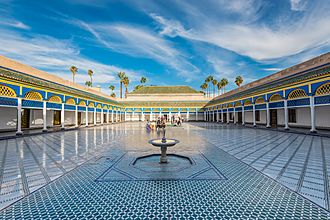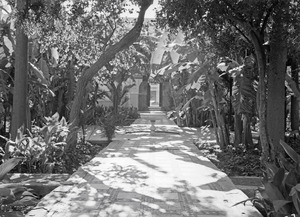Bahia Palace facts for kids
Quick facts for kids Bahia Palace |
|
|---|---|

The Grand Courtyard of the Bahia Palace
|
|
| General information | |
| Type | palace |
| Architectural style | Moroccan, Islamic |
| Location | Marrakesh, Morocco |
| Coordinates | 31°37′17.73″N 7°58′56.03″W / 31.6215917°N 7.9822306°W |
| Construction started | 1859 (or 1860s) |
| Completed | 1900 |
| Design and construction | |
| Architect | Muhammad ibn Makki al-Misfiwi |
The Bahia Palace (Arabic: قصر الباهية, Berber languages: ⵜⴰⴳⴰⴷⵉⵔⵜ ⵏ Иⴱⴰⵀⵢⴰ) is a beautiful palace in Marrakesh, Morocco. It was built in the late 1800s. The palace was started in 1859 by Si Musa, a powerful minister for Sultan Muhammad ibn Abd al-Rahman.
Later, his son, Ba Ahmed, made the palace much bigger. Ba Ahmed was also a very important minister for Sultan Moulay Abdelaziz from 1894 to 1900. Today, the Bahia Palace is a famous historical building and a popular place for tourists to visit.
History of the Bahia Palace
Building the Palace
Si Musa came from a family that served the Moroccan royal government. He rose to become a very high-ranking official. He was first a chamberlain and then the grand vizier (a top minister) for Sultan Muhammad IV.
Si Musa began building the palace in 1859. He continued working on it through the 1860s. The northern part of the palace, including the "Grand Riad" (a large garden) and its nearby rooms, dates from Si Musa's time. These older parts are sometimes called the Dar Si Moussa. Some rooms in this area have inscriptions showing they were built in 1866-67.
Ba Ahmed, Si Musa's son, became a powerful minister for Sultan Moulay Hassan. When Sultan Hassan died, Ba Ahmed helped his son, Abdelaziz, become the new Sultan in 1894. Because Sultan Abdelaziz was only sixteen, Ba Ahmed became the real ruler of Morocco until he died in 1900.
During these years, Ba Ahmed kept expanding his father's palace. He bought more land and added new sections piece by piece. His architect was Muhammad ibn Makki al-Misfiwi. The palace grew so much that it changed the layout of the nearby streets. The palace was home to Ba Ahmed's many servants and his family. The name al-Bahia means "the Brilliant," and it was said to be the name of his favorite wife. The entire palace was built on one level, possibly because Ba Ahmed found it difficult to use stairs.
From Royal Home to Tourist Spot
After Ba Ahmed died, the palace became the property of the royal family. Sultan Abdelaziz, who then took full power, reportedly ordered the palace to be emptied of its valuable items. In 1908, Madani el-Glaoui took over the palace. He added an upper floor to some parts of the building.
In 1912, when France took control of Morocco, the palace became the home of the French Resident-General, Hubert Lyautey. After Morocco became independent, the palace was used by King Mohammed V. Later, King Hassan II gave it to the Moroccan Ministry of Culture. They turned it into a popular place for tourists to visit.
Today, the Bahia Palace is one of the most visited places in Morocco. Many people come to see its beautiful architecture and gardens. Sometimes, the King of Morocco still uses the palace to welcome important visitors from other countries or to host special events.
Palace Design and Beauty
How the Palace is Laid Out
The Bahia Palace has a confusing layout, like a maze. This is because it was built in many different stages over the years, without one clear plan. It has several inner courtyards and riad gardens. These are special gardens divided into four equal parts. Rooms and halls are built around these gardens. The main palace covers almost 2 hectares (about 5 acres).
You enter the palace grounds through a large archway. A long garden path leads you to the palace itself. A smaller courtyard then takes you to the Small Riad. This is a square garden with paths crossing in the middle. It is surrounded by beautifully decorated halls and rooms. One of these rooms was Ba Ahmed's Council Chamber. An apartment on the second floor above this riad was added later by Madani el-Glaoui.
East of the Small Riad is a small inner courtyard, called the Small Courtyard. It is surrounded by fancy rooms. East of this is the Grand Courtyard, which is the most impressive part of the palace. It measures 50 by 30 meters (about 164 by 98 feet). The floor is made of white Italian Carrara marble. An elegant wooden gallery with colorful designs surrounds it. These galleries lead to about 80 rooms. At the east end of this courtyard is a grand hall with a high ceiling. This hall has some of the best painted decorations in the palace. It was built around 1896-1897.
North of the Grand Courtyard is another large area called the Grand Riad. This is the oldest part of the palace, built by Ba Ahmed's father, Si Musa. The courtyard has a very large garden with trees that are still from the 1800s. On the east and west sides of the garden are two grand halls with amazing decorations. These halls were built in 1866-67.
Further east, outside the main palace, are the remains of gardens and parks created by Ba Ahmed. This area used to be a garden from an older time. On the south side of the palace, there are other buildings, including stables and a mosque with a tall minaret.
Amazing Decorations
The palace is most famous for its beautiful decorations. The walls are covered in stucco carvings. These carvings show Arabic writing, geometric patterns, swirling designs called arabesques, and special honeycomb-like carvings called muqarnas. The floors are covered with marble and colorful zellij tiles.
One of the most famous features is the cedar-wood ceilings. They are painted with bright floral patterns. The large doorways also have carved and painted wooden canopies. Ba Ahmed brought materials for these decorations from all over Morocco. This included marble from Meknes, cedar wood from the Middle Atlas mountains, and tiles from Tétouan. Skilled artists and builders from all over the country worked on the palace.
Gallery
Entrance of the palace
The Small Riad
-
The courtyard and garden of the Small Riad
The Small Courtyard
The Grand Courtyard
-
A glimpse of the minaret of the palace mosque, seen from the Grand Courtyard
Private apartment of Ba Ahmed's wife
The Grand Riad (Dar Si Moussa)
See also
 In Spanish: Palacio de la Bahía para niños
In Spanish: Palacio de la Bahía para niños

































